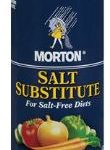 We eat too much salt. Commercial food is prepared with too much salt. Even products you know to be salted may be much saltier than you realize. Salt in excessive quantities causes fluid retention and promotes high blood pressure. We really need to be conscious of the amount of salt we are eating on a daily basis.
We eat too much salt. Commercial food is prepared with too much salt. Even products you know to be salted may be much saltier than you realize. Salt in excessive quantities causes fluid retention and promotes high blood pressure. We really need to be conscious of the amount of salt we are eating on a daily basis.
Some Explanatory Chemistry Details
Table salt is primarily sodium chloride (NaCl) with tiny amounts of iodide to promote normal thyroid function together with a silicate to minimize water absorption so the salt continues to flow in moist air.
Sodium is the major cation (positively charged ion) in the body fluids (blood, spinal fluid, fluid between our cells). Sodium concentration in the blood is tightly controlled by the kidneys which retain or excrete water and sodium as needed. Plants and animal flesh that we eat as food contain relatively little sodium themselves before they are processed.
Potassium is the major cation in the body cells which contain much more total fluid than exists outside the cells. Potassium concentrations are also monitored and regulated by the kidney. We get potassium especially from fruits and vegetables, but it is substantially present in almost any living thing (plant or animal) that we eat.
When we eat excess salt, the kidneys retain extra water to dilute the salt and maintain the proper concentration (about 140 mEq/l) until the kidneys have enough time to excrete excess sodium (hours to several days). During that time, the blood volume and total body fluid volume may go up, blood pressure may rise, and we may get fluid collection in the lower extremities and feel bloated in the abdomen. All these changes are induced by excess intake of NaCl.
Potassium is rarely in excess from dietary causes. Even if you eat lots of peaches and grapes and other fruit which are high in potassium, a normal kidney can easily compensate by excreting excess potassium. By contrast, we are relatively easily subject to low potassium levels which can cause weakness and irregular heart beats from intestinal loss of fluid during severe bowel infections and vomiting.
How Much Salt Is Too Much?
Major medical organizations agree that daily sodium intake should not exceed 1500 mg for adults over 50 in general, for all African Americans, or for anyone with high blood pressure, kidney disease, or diabetes. These groups collectively constitute the majority of adults in this country. For younger people and adults free of those major chronic diseases, the recommendation is not more than 2300 mg of sodium. The CDC (Centers for Disease Control and Prevention) website has a clear and concise summary of the recommendations.
How much salt (sodium chloride) gets you 1500 mg of sodium? Amazingly little. A level teaspoon of table salt contains about 6000 mg of NaCl, which in turn contains about 2400 mg (40%) of sodium. So between one-half and two-thirds of a teaspoon of table salt contains the complete 1500 mg daily maximum of sodium. And 1 tsp contains the maximum desired amount for younger people. Again, this is not the amount of table salt you should have per day, but the total sodium from all dietary sources.
Where Is the Salt in Food?
Foods that are processed and packaged for you are frequently scarily high in sodium (Na). A few examples:
- Canned soups often 900 mg Na per 8 oz
- Campbell’s tomato juice 680 mg Na per 8 oz
- Soy sauce 950 mg per tablespoon (1/2 oz)
- Parmesan cheese 430 mg per oz
- Kirkland precooked bacon 330 mg/4 slices (about 600 mg/oz)
- cottage cheese 400 mg/4 oz serving
- Bumble Bee chunk light tuna in oil 500 mg/4 oz
- Hellman’s Mayonnaise 180 mg/oz
- Olives (bottled) 467 mg/oz
- Sour pickle 1087 mg/3 oz medium
- KFC chicken breast with skin 530 mg/3 oz
What about some foods that do not have so much sodium? Here is the sodium content of a few similar raw or differently processed foods, substantially or vastly lower than the examples above:
- Raw tomatoes 2 mg/oz
- Campbell’s low-sodium tomato juice 141 mg/8 oz
- Pork loin 15 mg/oz
- Fresh bluefin tuna, 48 mg/4 oz
- cucumbers 3 mg/3 oz
- chicken breast 57 mg/3 oz
Be More Aware of Food Salt Content
The message you should get from this discussion is that our food environment, as we experience it through purchased packaged and prepared foods, as well as many restaurant dishes, contain vast amounts of salt that will rapidly propel us far past the desired daily intake limit of 1500 mg of sodium, without so much as ever picking up a salt shaker at the table (more on that below).
You should read labels and check the sodium content of all foods you purchase. There are many surprises. For example, there are about 7 olives per oz in bottled olives of varying sizes. I counted and measured. That means each olive has about 70 mg Na. I was astounded. How many do you nibble? You may want to limit quantities or change your food choices or begin to seek out low-sodium versions of the same product. (The low-sodium Campbell’s tomato juice saves 500 mg per 8-oz glass! Isn’t that extraordinary?) I certainly am limiting my pickle and olive intake since noting how dramatically salty they are.
Most Salts Similar, Except KCl
For those times when you may need more added salt for flavor, either in cooking or for flavor at the table, consider trying a potassium chloride salt (KCl) rather than standard sodium chloride (NaCl). The flavor is quite similar and substitution is generally unnoticeable. An example would be Morton’s Salt Substitute in its blue cylindrical dispenser. Again, potassium chloride salts contain no sodium. Unless you use dramatically large amounts of KCl, you cannot harm yourself as you can with standard table salt.
By contrast, all other popular salts (whether traditional kosher salt, rock salt, sea salt, or newly marketed “Himalayan” salt) are almost completely standard sodium chloride in coarser format or with a few other minerals included naturally in the evaporation process that produces granular salt. They all add up closely to the same 2400 mg of sodium per teaspoon. None is better for you or healthier. All have to be limited as part of the 1500 mg maximum daily sodium intake.
Final Take Home and Home Work
Finally, consider more home cooking. Use more fresh produce and protein sources, fewer prepared foods, watch out for any cured products since they are all intensely salty, and learn more flavoring techniques with spices that do not require extensive salt or experiment with a potassium salt substitute. You can also seek out low-sodium products from Web sources such as http://www.lowsaltfoods.com/ or your friends. There are many options. Always read the nutrition information label.
I would also suggest you post your own ideas and discoveries here, such as one or two of your favorite foods that you realized were unreasonably salty and what you found to substitute for them. Everyone has different tastes. I am busy researching and tasting low-salt sardines and low-sodium parmesan, for example. Let’s help each other eat tasty but healthier food.


Given the function of the kidney, how much water should a person consuming average amounts of salt drink every day? It seems like the more water you drink, the less harmful the effects of salt in your diet. True?